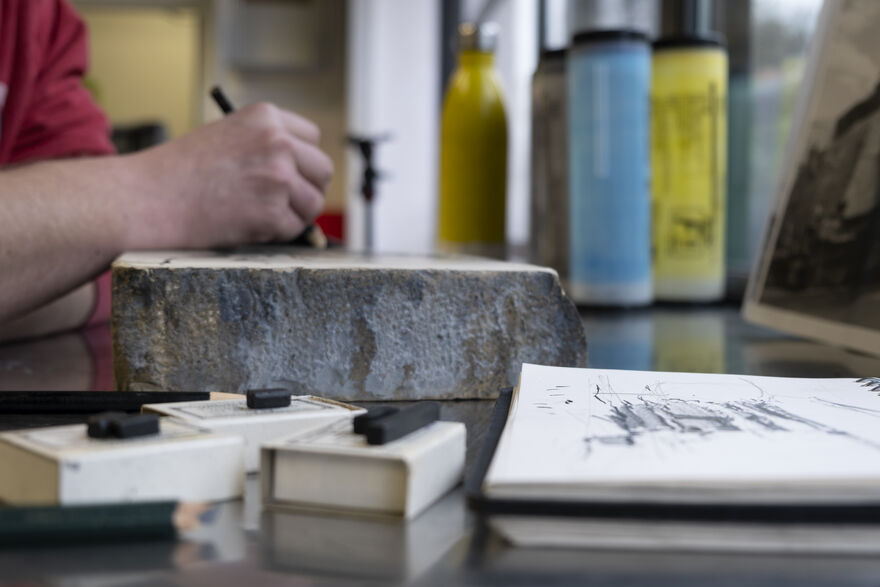
Stone lithography allows you to draw: Q&A with Calum Wallis
The tutor of our Stone Lithography Masterclass shares more about this fascinating process
As part of our summer programme, we're excited to be hosting a masterclass in Stone Lithography.
Taught by local artist Calum Wallis, this in-depth, three-day course will delve into this traditional printmaking process that was developed in the late 18th century. The process allows for a greater range of marks and tone to be captured when printing, creating detailed images with a drawn or painterly style.
We caught up with Calum to find out more about stone lithography and captured some of his progress as he worked on a new print in the studio...
Published

Can you tell us a little bit about yourself and your practice?
My practice of landscape drawing and printmaking stems from the tactile experience of a place. I grew up taking great joy in scrambling and exploring among the beaches and forests of the Highlands. Over time, a curiosity about what might be hidden in the landscape has become a curiosity about how the landscape was formed and how it continues to form. Through close drawing and repeated revisiting of geological features, my work endeavours to document the process of erosion and render deep time visible to the human eye.

What's your relationship with DCA Print Studio?
Since moving to Dundee over a decade ago, I've been aware of DCA Print Studio as an exciting hub of creativity and experimentation in the city, and have frequently seen the work produced there. It was only recently that I have started to work in the studio and I find its integration with the outside world a hugely attractive feature - the public are just outside, and the works made in here are frequently shown around the building. This feels like a contrast from many creative spaces which can feel far removed from the world at large.
More than any other printing process, stone lithography allows you to draw, thanks to it's ability to reproduce a full tonal range.

What attracted you to stone lithography?
I was first attracted to stone lithography for the possibility of accurately reproducing a drawing multiple times, but quickly became enchanted by the arcane peculiarities of this process. There is nothing quite like the cold smooth limestone as a drawing surface on which marks can be made in a myriad of different ways, from the slow and meticulous to the vigorous and gestural. More than any other printing process, stone lithography allows you to draw, thanks to its ability to reproduce a full tonal range.

Can you tell us a bit about the stone lithography process?
The process of stone lithography has many steps - we grain the stone, make our drawings on the stone, etch these drawings into the stone with chemical solutions before removing the drawings completely and replacing our drawing materials with ink. This is my favourite part of the process as it involves your drawing fully vanishing before reappearing as you roll ink into the stone. Then we pull prints from the stone in teams, with one person wetting the stone repeatedly to repel ink from the drawn areas and another rolling ink onto the surface ready to receive paper and pressure.

What can people expect from your Masterclass at DCA?
People can expect an involved and magical process which will produce unexpected and exciting results. Each person will work on their own stone and produce a print from start to finish. A common misstep for those first coming to stone lithography is that of having a very particular and exacting outcome in mind for their print - while this level of mastery can be achieved with years of involved study and practice, it is not the aim of this workshop. Rather, I will encourage people to be curious about the different materials and surfaces and to try producing a drawing in a new and exciting way.
People can expect an involved and magical process which will produce unexpected and exciting results.

